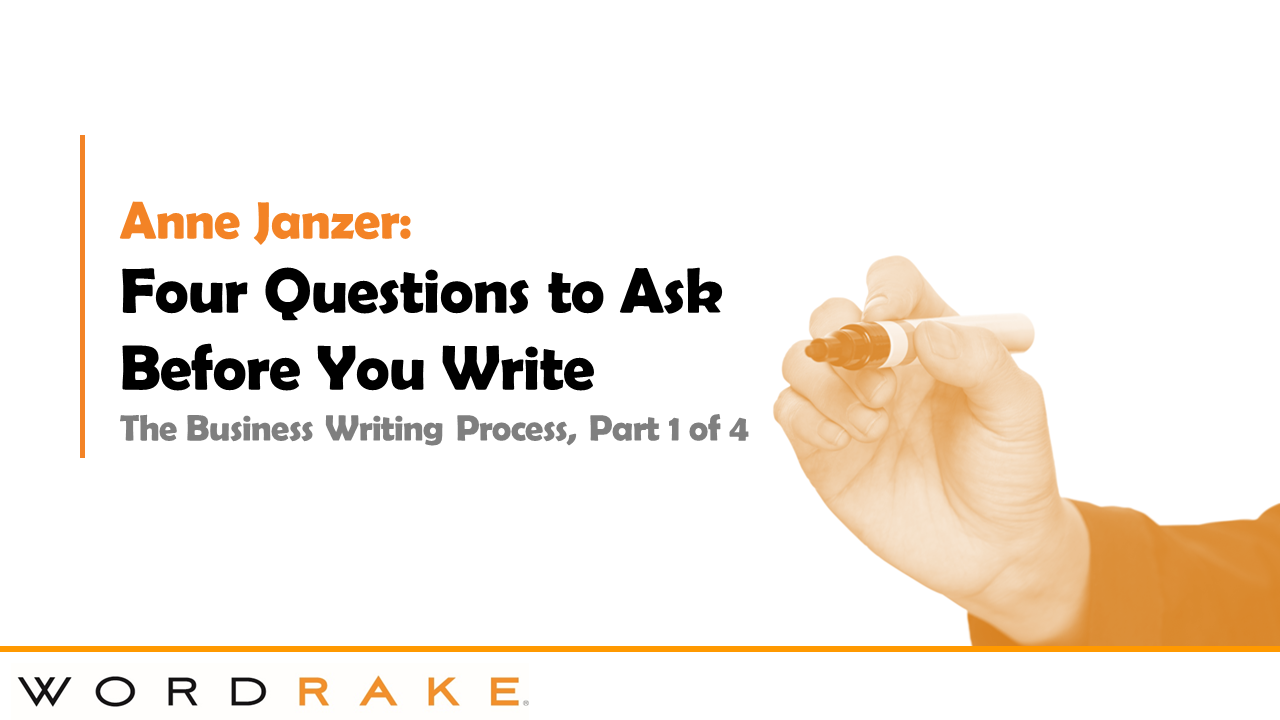You need to write an important report or blog post. It’s a task like any other, right? You set aside a block of time and swear not to leave the desk until it’s done.
If you have high standards for your work, you may not be pleased with what you write. Being diligent, you keep going, perhaps banging your head against a metaphorical wall or flashing back to late night papers in college. It takes longer than you hoped to get to a decent draft and the process isn’t fun.
Does this sound familiar?
It gets worse. Because the experience was unpleasant, the next time you have a writing project, you put it off. (Who is eager to do something unpleasant?) Now you’re up against a deadline, perhaps working in the evening or weekend.
Thinking of writing as a single task puts too much pressure on the work and kicks off a vicious cycle that makes you avoid your writing projects. Break that cycle!
When you think of writing as a repeatable process with multiple smaller steps, you’ll have better success and less stress. This approach also fits more easily into a busy schedule, leaving your evenings and weekends free for other things.
Writing Is a Process, Not a Task
Reframe the way you think about writing. It’s not a single skill. Rather, it’s a complex set of mental activities:
-
Wide-ranging focus (to hunt for ideas and find the right words)
-
Attention to detail (to hit your key points and create a coherent argument)
-
Cognitive empathy (to envision the reader’s needs)
-
A critical eye (to improve the prose)
Add the additional burdens of search engine optimization or legal compliance and your brain might well overheat.
No one can balance all these things at once. It’s like juggling chainsaws and teacups.
When you pull apart writing into smaller components, you can bring the right mental state to each task. The process is more pleasant, and you spend less total time on the effort.
The Different Parts of the Process
There’s no single “correct” way to divide up writing. You may have your own, idiosyncratic approach. Here’s a seven-step plan that works for most people and projects:
-
Research and brainstorm the topic
-
Outline or structure the piece
-
Write an incomplete, imperfect first draft
-
Take a second pass to fill in the holes and assess whether it meets its objectives
-
Read it through for flow and readability. Elevate the writing.
-
Bring a critical eye and polish the words
-
Publish or hit “Send”
With this approach, you only need to do one or two small tasks each day, then trust yourself to take the next step the following day.
You can easily fit the work into one five-day work week by combining them as needed.
Let’s say you promise to publish an important blog post in one week, next Monday. Rather than sacrificing your weekend, start the Monday before. Here’s how it might play out.
Monday (one week before the deadline): Brainstorm and outline
Give yourself 30 minutes to research and brainstorm the topic. Revisit the purpose for the piece and the reader’s needs. (See my previous post “Four Questions to Ask Before You Write.”)
Next, create an outline, using whatever format you like:
- An old-school numbered outline
- A bunch of note cards
- A mind map
- A scribbled drawing on a piece of paper
I know a friend who composes three Tweets for every blog post, then crafts the post around those tweets.
Whatever you do, make sure you can decipher it tomorrow.
Tuesday: Write the rugged rough draft
Today, look at your outline and write down as much as you can into a rough draft. Work quickly.
- If you get stuck, skip ahead.
- Are you missing a piece of data? Make a note and keep moving.
Write in any order. You can start with the conclusion, then fill in what comes before. You’ll fix the flow tomorrow.
If you struggle with a section, that’s fine. Let it incubate between now and tomorrow. (See my previous post called “Schedule Incubation Time for Your Ideas.”)
Wednesday: Patch and assess
You’ve had a night to sleep on it. Today, open the file and clean it up.
- Fill in any missing sections
- Rearrange anything that seems off
- Check any facts and find the research to support your point
Return to your plan for the project. (If you answered the Four Questions for this project, return to those answers now.)
- Does this piece meet your objectives?
- Given what you know about the reader, will it meet their objectives? Will they feel like they’ve invested their time well in reading it?
If it’s missing any critical content, this is your chance to add it. If the piece has strayed from its objectives, reign it back in.
Thursday: Bring a critical eye and ear
Now, at long last, you can elevate your writing to meet your own high standards.
Read the piece from beginning to end. Do you get stuck anywhere?
Try using your ear: read it aloud. Do you trip over sentences? Spot any non sequiturs or overused jargon? Does it sound boring or trite?
You can ask your computer to read it to you. (Microsoft Word has a Read Aloud feature in the Review pane.)
Make sure it makes sense. Shorten complex sentences that might lead the reader astray. Look for jargon and overused expressions.
You’re not done, though. You’ve got another day to make it shine.
Friday: Polish and perfect
Now that the words and ideas are where you want them, it’s time to unleash the software.
Run your piece through a spelling and grammar check. Let WordRake rake through your document and help you clarify and tighten your prose.
Then read the thing once again when it’s done. Just in case.
If you need to add images, this is a good time to hunt for them. Do whatever else you need to do before publication or distribution.
Take the weekend off without guilt.
Monday: Publish
On the day of the deadline, take one more look before you send it off or hit publish. You may spend only five minutes looking at a piece. Perhaps, though, you’ll see one more thing you want to add. If you do, run the software one more time.
Will it be perfect? Maybe not, but you can feel confident you’ve done your due diligence with this piece. You’ve put good work out into the world.
The Beauty of the Process
This sounds like a lot, but added up, it’s usually less time than you might spend “powering through” a writing project in one sitting.
If you have a busy or unpredictable schedule, you don’t need a big block of uninterrupted time. If you’re too busy one day, you can double up on tasks the next.
Best of all, this approach is low-pressure. Your “inner critic” doesn’t even show up for the work until later in the week.
The next time you have a writing project, challenge yourself to not do it all at once, but to divide up each step of the process. You might be surprised how easy writing suddenly becomes.
About Anne Janzer
Anne Janzer is an enthusiastic WordRake user, an award-winning author, armchair cognitive science geek, nonfiction author coach, marketing practitioner, and blogger. She’s on a mission to help people spread important ideas through writing. As a professional writer, she has worked with more than one hundred technology companies, writing in the voice of countless brands and corporate executives. Her books include 33 Ways Not to Screw Up Your Business Emails, Writing to Be Understood, and Subscription Marketing. They have been published in Japanese, Korean, and Russian and are used in college writing courses. Find her blogs and review of WordRake on AnneJanzer.com.
Series on the Business Writing Process
This is part 3 of the four-part series The Business Writing Process by award-winning author Anne Janzer. Make WordRake part of your writing routine. Take the pressure off the writing process and deliver your best, most polished writing with the help of WordRake’s edit suggestions. WordRake makes reviewing your writing faster and easier, which helps you deliver a high-quality written product on schedule. WordRake editing software is available for Microsoft Word and Outlook on Windows or for Microsoft Word only on Mac. You can try it free for 7 days.








